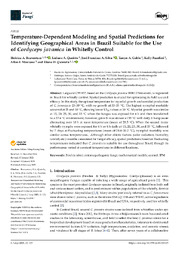Embrapa Rice & Beans
Temperature-dependent modeling and spatial predictions for identifying geographical areas in Brazil suitable for the use of Cordyceps javanica in whitefly control.
Temperature-dependent modeling and spatial predictions for identifying geographical areas in Brazil suitable for the use of Cordyceps javanica in whitefly control.
Author(s): BOAVENTURA, H. A.; QUEIRÓS, L. A.; SILVA, J. F. A. e; GOBLE, T. A.; PAZOLINI, K.; MARCIANO, A. F.; QUINTELA, E. D.
Summary: Lalguard C99 WP, based on the Cordyceps javanica BRM 27666 strain, is registered in Brazil for whitefly control. Spatial prediction is crucial for optimizing its field use and efficacy. In this study, the optimal temperature for mycelial growth and conidial production of C. javanica is 25–30 ?C, with no growth at 33–35 ?C. The highest nymphal mortality occurred at 25 and 30 ?C, showing lower LT50 values at 30 ?C. Mycelial growth was similar at 15, 20, 25, 30, and 35 ?C when the fungus was exposed for 6 h and then transferred to a 27.4 ?C environment; however, growth was slower at 35 ?C with daily 6 h exposure alternating over 18 h at room temperature (mean of 28.5 ?C). When the second instar whitefly nymphs were exposed for 6 h or 6 h daily at 15, 20, 25, 30, and 35 ?C, followed by 7 days at fluctuating temperatures (mean of 28.4–30.2 ?C), nymphal mortality was similar across temperatures. Although other abiotic factors (solar radiation, humidity, rainfall, etc.) must be considered for fungal efficacy, spatial predictions based on fluctuating temperatures indicated that C. javanica is suitable for use throughout Brazil, though its performance varied at constant temperatures in different locations.
Publication year: 2025
Types of publication: Journal article
Unit: Embrapa Rice & Beans
